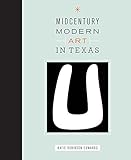Midcentury Modern Art in Texas / Katie Robinson Edwards.
Material type: TextPublisher: Austin : University of Texas Press, [2021]Copyright date: ©2014Description: 1 online resource (391 p.)Content type:
TextPublisher: Austin : University of Texas Press, [2021]Copyright date: ©2014Description: 1 online resource (391 p.)Content type: - 9780292756649
- 709.764/0904 23
- N6530.T4 E35 2014eb
- online - DeGruyter
| Item type | Current library | Call number | URL | Status | Notes | Barcode | |
|---|---|---|---|---|---|---|---|
 eBook
eBook
|
Biblioteca "Angelicum" Pont. Univ. S.Tommaso d'Aquino Nuvola online | online - DeGruyter (Browse shelf(Opens below)) | Online access | Not for loan (Accesso limitato) | Accesso per gli utenti autorizzati / Access for authorized users | (dgr)9780292756649 |
Frontmatter -- Contents -- Acknowledgments -- 1. The Modernist Impulse and Texas Art -- 2. The 1930s and the Texas Centennial -- 3. Houston and the Foundations of Early Texas Modernism -- 4. Early Practitioners of Abstraction and Nonobjectivity -- 5. The Fort Worth Circle -- 6. The University of Texas at Austin in the 1940s and 1950s -- 7. The 1950s and Houston -- 8. Sculpture in and around the Studio of Charles Williams -- 9. Are Texans American? -- Postscript -- Appendix. Selected Artists’ Biographies -- Notes -- Bibliography -- Illustration Credits -- Index
restricted access online access with authorization star
http://purl.org/coar/access_right/c_16ec
Before Abstract Expressionism of New York City was canonized as American postwar modernism, the United States was filled with localized manifestations of modern art. One such place where considerable modernist activity occurred was Texas, where artists absorbed and interpreted the latest, most radical formal lessons from Mexico, the East Coast, and Europe, while still responding to the state’s dramatic history and geography. This barely known chapter in the story of American art is the focus of Midcentury Modern Art in Texas. Presenting new research and artwork that has never before been published, Katie Robinson Edwards examines the contributions of many modernist painters and sculptors in Texas, with an emphasis on the era’s most abstract and compelling artists. Edwards looks first at the Dallas Nine and the 1936 Texas Centennial, which offered local artists a chance to take stock of who they were and where they stood within the national artistic setting. She then traces the modernist impulse through various manifestations, including the foundations of early Texas modernism in Houston; early practitioners of abstraction and non-objectivity; the Fort Worth Circle; artists at the University of Texas at Austin; Houston artists in the 1950s; sculpture in and around an influential Fort Worth studio; and, to see how some Texas artists fared on a national scale, the Museum of Modern Art’s “Americans” exhibitions. The first full-length treatment of abstract art in Texas during this vital and canon-defining period, Midcentury Modern Art in Texas gives these artists their due place in American art, while also valuing the quality of Texan-ness that subtly undergirds much of their production.
Mode of access: Internet via World Wide Web.
In English.
Description based on online resource; title from PDF title page (publisher's Web site, viewed 26. Apr 2022)


